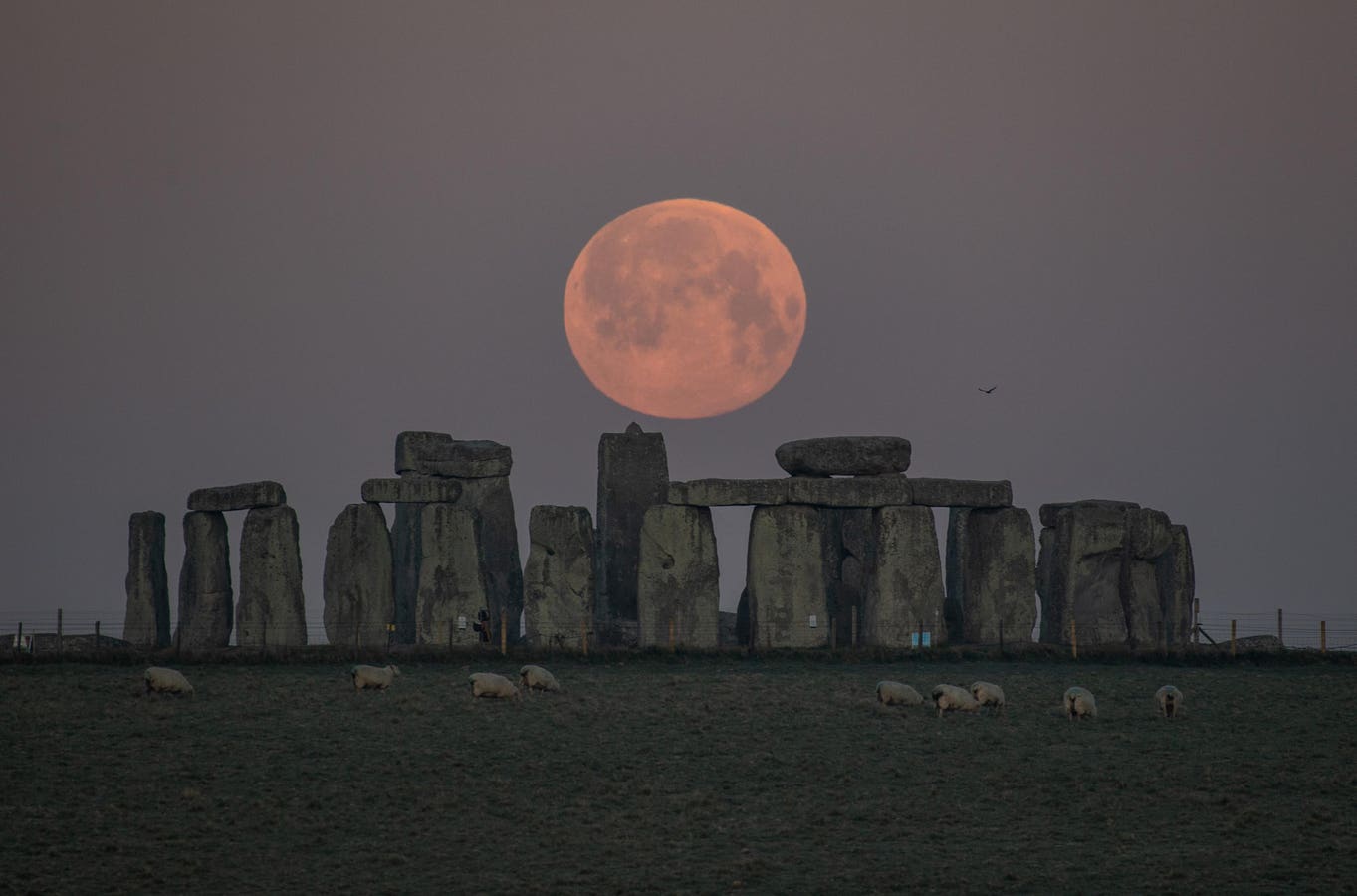A newly drafted recommendation to UNESCO’s World Heritage Committee meeting in July in India advises that the Stonehenge and Avesbury World Heritage Site should be placed on the List of World Heritage in Danger due to the threat from the A303 road scheme, approved by the U.K. government last year.
The recommendation is contained in a report released on June 24 and increases the warning notices previously issued by UNESCO. The report reveals that the U.K.’s National Highways body has proposed changes to the scheme to try and disguise the deep cutting through the Bronze Age landscape on the western side of the site. These include ‘cantilevered sides’ and another ‘green bridge’ adding $75 million to the scheme costs.
However, these do not appear to have addressed UNESCO’s concerns. Also revealed is the level of frustration with the U.K. Government’s attitude towards its obligations under the World Heritage Convention.
While U.K. Prime Minister Rishi Sunak criticized Just Stop Oil protestors after they sprayed Stonehenge with rain-dissolvable orange cornflour powder the day before the Summer Solstice earlier this month his government is pressing on with a road tunnel that could alter the monuments ritual landscape for ever.
The incoming (most likely) Labour Government will inherit the scheme and will have to decide on its future.
John Adams, chair of the Stonehenge Alliance, said of the UNESCO recommendations: “This is a damming verdict on National Highways’ plans. Its minor tweaks have quite rightly cut no ice with UNESCO. You can put lipstick on a pig, but it is still a pig. Whichever way you look at it, this scheme will be hugely damaging and should be scrapped. The money should be spent instead on improving public transport links to and around the South West. That would be the best way of reducing pressure on the A303, while still retaining the view of the Stones for passing travellers.”
Tom Holland, president of the Stonehenge Alliance added: “The new Government will have the perfect opportunity to reverse a road scheme that is not only ludicrously expensive, but risks huge damage to the country’s international reputation.
According to UNESCO’s report the U.K. government’s revised proposals for the Stonehenge road tunnel would “have only very modest visual benefits.”
The report states that: “The two bridges would allow access across the four-lane highway, but would not minimise, or even reduce the impact on archaeological resources or the integrity of the landscape.
UNESCO has long recommended an extension to the tunnel beneath the Stonehenge landscape, a revision the U.K. government has rejected as too costly.
In July last year the U.K. government gave the go-ahead for a tunnel close to the Stonehenge standing stones. UNESCO told the U.K. government soon afterwards that the scheme “should not proceed in its current form.”
The UN cultural body said that the “currently proposed western portal and associated dual carriageway within a cutting would have significant and inappropriate adverse impacts on the physical and visual integrity of the property.”
Transport secretary Mark Harper—one of many Conservative ministers possibly voted out on the July 4 general election—unveiled the latest decision to proceed with the tunnel near Britain’s most famous World Heritage Site (WHS) on July 14. Previous transport secretaries have made similar decisions only for them to be later overturned following worldwide protests.
In September last year, members of the Stonehenge Alliance and Save Stonehenge World Heritage Site (SSWHS) travelled to Paris to present UNESCO with a copy of a 225,000 signature petition, from 147 countries, calling on the U.K. Government not to build its road scheme through the Stonehenge World Heritage Site.
Stonehenge could be stripped of its WHS status if the scheme goes ahead unaltered.
Chris Todd, director of Transport Action Network (TAN), a member of the Stonehenge Alliance and a director of SSSWHS said:
“Stonehenge could lose its World Heritage Site status if this road scheme goes ahead unaltered. This would be an international embarrassment for the U.K. Only three World Heritage Sites have ever been delisted since the signing of the World Heritage Convention in 1972. The most recent was Liverpool in 2021, which also happened under this Government’s watch. To lose one WHS is bad enough, but to lose two would show a failure of leadership and responsibility for both humanity and future generations.”
Harper approved an application by Highways England for consent to build a 1.8-mile road tunnel to reroute a trunk road away from the standing stones on Salisbury Plain, near Amesbury, Wiltshire.
The U.K’s Planning Inspectorate has previously said the tunnel would case “permanent, irreversible harm” to Stonehenge’s ritual landscape.
In a 64-page decision letter, Harper agreed. He admitted “there will be harm as a result of the development to cultural heritage and the historic environment.”
Road to the sun
The government announced plans to bury the “road to the sun”—or, less prosaically, the A303—in 2017, although a “relief road” in one shape or another has been proposed at this location for at least 50 years. Previous plans were rejected for being too damaging to the World Heritage Site or if the proposed damage was removed almost entirely, too costly.
A bored tunnel would divert the road away from the stones, but, say, historians, it would damage other parts of what was once a much broader ritual landscape.
In 2020, archeologists using high-tech, non-invasive imaging techniques revealed to an astonished world that the Neolithic peoples who constructed Stonehenge also dug a series of shafts aligned to form a circle spanning 1.2 miles in diameter, 2 miles north-east of Stonehenge.
Co-principal investigator of the Stonehenge Hidden Landscape project Vincent Gaffney said at the time: “This is an unprecedented find of major significance within the U.K.”
The University of Bradford professor added: “Key researchers on Stonehenge and its landscape have been taken aback by the scale of the structure and the fact that it hadn’t been discovered until now so close to Stonehenge.”
Building the tunnel would be an “act of monstrous vandalism” that would be hard to justify to generations to come, said Professor Gaffney.
Junior transport minister Andrew Stephenson told parliament in 2020 that “following notification of a recent archaeological find within the World Heritage Site, the deadline for the decision is to be further extended to 13 November 2020 to enable further consultation on and consideration of this matter.”
The Department for Transport granted planning consent but in July 2021, the High Court of Justice quashed this decision. Following this judgement, the Secretary of State was required to review the application.
In addition to burrowing beneath the ritual landscape—which draws in tourists to Britain from around the world—the $2.3 billion plan would be used to widen the A303 to “Expressway” standard. The tunnel is planned to have twin portals in deep dual-carriageway cuttings, and there will be junctions—described as “Expressway Interchange” and “Expressway Flyover”—on the scheme’s boundaries.
The Department for Transport (DfT) has said that it wants to “transform the route into an expressway, a new type of strategic road which is as safe and reliable as a motorway and where ‘mile-a-minute’ journeys are the norm.”
Officially known as the “A303 Amesbury to Berwick Down Improvement,” the tunnel scheme is likely to cost far more than the budgeted billions.
“Based on experience, project costs tend to grow rather than fall, at least in the early years,” said Amyas Morse, the head of the National Audit Office (NAO) in 2019.
“It will take a very special effort by the [DfT] to protect public value up to completion,” he added.
A report from the NAO cast doubt on the whether the project would ever represent value for money. The independent parliamentary body responsible for auditing government departments questioned the government’s cost-to-benefit ratio methodology used for evaluating the worth of infrastructure projects.
In order for the project to deliver $1.55 in benefits for every $1 spent, Highways England included a monetary value for “cultural heritage” in the costings. This was worked out by asking people how much they would pay to have the road removed from the site.
“While Highways England used approved methodologies, calculating benefits in this way is inherently uncertain,” said the NAO report.
Responding to the 2019 report a DfT spokesperson said: “Stonehenge is a site of significant historical value—we have worked closely with heritage groups, including English Heritage and Historic England, to ensure it is protected both during the upgrade of the A303 and in the long-term.”
“The Stonehenge World Heritage Site [WHS] is one of the few place where you can see a special, sacred landscape developed over thousands of years,” Neolithic expert Mike Parker Pearson said in 2018.
“To tunnel beneath part of the WHS and gouge huge cuttings through the archaeologically sensitive ground for a 4-lane Expressway [would be] a disastrous decision by government,” added Professor Pearson.
$35 billion road building plan
The DfT released a plan to “decarbonize” transport in March 2020. In a foreword, Grant Shapps—another Tory minister at risk of being rejected by voters—said that “we will use our cars less.” However, later the same year the new Chancellor of the Exchequer, now Prime Minister, Rishi Sunak claimed in his first budget speech that he was unveiling the “largest ever investment in English strategic roads” and would be pressing ahead with a $35 billion program of road building over the next five years.
Delaying the scheme had been welcomed by campaigners because pushing ahead with what many consider to be a historically-illiterate road-building scheme close to Stonehenge would, they say, be odd in the extreme, would shock people around the world—so-called “global Britain” trashing its most famous historic site isn’t a good look—and would likely to face massive protests long before the first diggers moved in.
In theory, building the tunnel could see the megalith-dotted landscape returned to chalkland pasture and improve amenities for cyclists and pedestrians, who currently find it almost impossible to use the perpetually busy A303. However, campaign groups argue that such access is likely to be watered down and that building the tunnel will not solve congestion and would increase car dependence.
Put out to grass
Since 1991, fifty-one “road improvement” proposals have been considered for the A303. The tunnel scheme was first proposed in 1994, and thrown out two years later as too costly. It reappeared in the government’s 2006 Road Program, and withdrawn the following year. The government reintroduced putative plans for a Stonehenge tunnel in 2014, and firmed them up in 2017.
Instead of majoring on the potential for improved views over Stonehenge, the Department for Transport’s 2017 announcement stressed the plans were “part of roads package to cut congestion in the south-west.”
In 2013, following work on a new visitor center, the A344 between Stonehenge Bottom and the megaliths was closed to all traffic and “grassed over.”
A Highways England video of the proposed new bypasses and the tunnel shows that the government plans to “de-trunk” the A303, which currently runs close to the megaliths, with the “old” road converted into use for non-motorized users.
The Department for Transport’s announcement for the scheme described it as the “A303 corridor,” code for the fact there will be more than just one road. There are a number of interlinked schemes with the Stonehenge stretch planned to become a “high quality, high performing route linking the M3 in the south-east and the M5 in the south-west.”
In March, Highways England revealed the names of three international joint venture contractors which will tender for the tunnel construction work. These are: BMJV, comprising Bouygues Travaux Publics and J Murphy & Sons; HDJV, (Hochtief Infrastructure and Dragados); and MORE JV (FCC Construcción, Salini Impregilo SPA and BeMo Tunnelling UK).
Car dependence
The Council for British Archaeology said in 2017 that there’s a “growing body of research suggesting that more radical approaches to transport policy, including a long term strategy to encourage a shift away from car-dependence, may well provide greater long-term sustainability than would any solution based on individual roadbuilding or improvement, and would welcome the opportunity to engage in discussions on this basis.”
The body stressed the international, multi-generational significance of the wider Stonehenge landscape: “Stonehenge should be seen not as a disembodied object but as a structure (one of the oldest in the world) with architectural attributes, and a critical element in a landscape of complex ritual sites. Its calculated location should be understood as embodying meaningful visibility, functional characteristics, an intended path of approach, an entrance, and much else. Decisions should flow from these insights.”
Chairman of Amesbury Museum and Heritage Trust, Andy Rhind-Tutt, described the tunnel plan as a “self-destructing time bomb,” which would “do nothing” for traffic problems in the area.
Read the full article here





